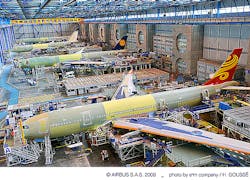Airbus announced it will reduce output of its A330 wide-body aircraft from 10 to nine jets per month in the fourth quarter of 2015 — a switch it stated would be a transition to production of the replacement A330neo series. The A330 (and the A330neo) jets are assembled at the Airbus complex in Toulouse, France.
The $600-million assembly plant that Airbus plans for Mobile, Ala., will the assembly of the A319, A320 and A321 narrow-body jets. It’s been speculated that Airbus my be due to increase production rates for the narrow-body jets, as Boeing has done with the competing 737 jets.
The A330 wide-body series includes the A330, A350 XWB and A380 – all jets capable of carrying 250 to over 500 passengers.
Airbus introduced the A330 in 1994 and has been building 10 of the aircraft each month since 2013. It claims this is a historically high rate of output in the industry for wide-body twin-engine aircraft, a category that accounts for most commercial airline flights. Airbus supplies A330 jets in freighter, VIP, and military transport/tanker variants, and noted that over 1,100 of the aircraft are in service currently with more than 100 operators worldwide.
“Our role as an aircraft manufacturer is to anticipate and adapt our output to ensure we continue to maintain a smooth production flow for Airbus and for our supply chain,” stated Tom Williams, Airbus’ executive vice president, Programmes.
“With the recent commercial success we’ve seen following the launch of the A330neo, in addition to the new 242-tonne weight variant and the A330 optimized for regional routes, we are confident we will sustain a steady production towards the A330neo ramp up period,” he continued.
Airbus is due to introduce the A330neo for service in Q4 2017.
Williams’ comments indicated there will be no effect on employment as a result of the reduction, and made clear the change in production will not be an end to the A330 series. However, the A33neo is considered a replacement to the current model, with the suffix “neo” designating a “new engine option.”
The A330neo will be powered exclusively by Rolls-Royce Trent 7000 engines (the current series offers options for General Electric, Pratt & Whitney, or Rolls-Royce engines) and other design changes to reduce fuel consumption, and that Airbus boasts will make the A330neo the most cost-efficient medium-range wide-body commercial aircraft.
About the Author
Robert Brooks
Content Director
Robert Brooks has been a business-to-business reporter, writer, editor, and columnist for more than 20 years, specializing in the primary metal and basic manufacturing industries.
